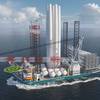NASSCO, BP Hold Naming Ceremony
Maureen Hayward, spouse of Tony Hayward, Group Chief Executive of Exploration and Production for BP, was the ship's sponsor, officially naming the Alaskan Explorer and striking a ceremonial bottle of champagne across the ship's hull.
Sharon Marshall, spouse of Steve Marshall, President of BP Exploration (Alaska), was her Matron of Honor. Bob Malone, Chief Executive of BP Shipping, Ltd., was the keynote speaker at the event. Dick Vortmann, President of NASSCO, also spoke.
The four BP ships are being constructed sequentially in NASSCO's 1,000-foot graving dock. The first ship, the Alaskan Frontier, was delivered to BP Shipping in August. It has completed five trips between Alaska and the West Coast, delivering 5.5 million barrels of Alaska North Slope (ANS) crude to the West Coast. "The Alaskan Frontier is performing extremely well in its early months of service and is meeting our every expectation for reliability, safety and efficiency," said BP's Malone. "We look forward to the addition of the Alaskan Explorer and her sister ships to continue our mission of safe, environmentally friendly transportation of cargoes to their destinations," added Malone.
The keel laying for the third ship was held in July. Construction on the steel blocks that will become the fourth ship in the class was started in October. The remaining three ships are scheduled to be delivered between now and the end of 2006. The BP project is keeping an estimated 1,000 NASSCO workers employed over the life of the contract.
The state-of-the-art double-hull ships have a length of 287 meters (94feet) and a beam of 50 meters (164 feet). The design of the 1.3-million-barrel-capacity tankers in the Alaska Class will allow maximum flexibility for oil deliveries from Alaska to West Coast ports, including BP refineries in Los Angeles, Calif., and Cherry Point, Wash.
The Alaskan Explorer's double hull has been designed for a life of 50 years and the deck structure has a life of 35 years, a robust configuration that will perform at peak efficiency for decades in the rigors of the Gulf of Alaska.
The Alaska-class ships are the most environmentally friendly tankers ever built. These ships use seawater instead of oil to cool and lubricate their propeller shafts, thus eliminating accidental oil leaks. Their cargo piping, normally installed on the deck, is inside the cargo tanks, to reduce the risk of small spills. The ships have twin diesel-electric propulsion systems in separate engine rooms, powering two propellers and twin rudders. Diesel-electric propulsion was chosen because it significantly increases reliability and reduces air emissions and maintenance downtime.
When completed, the ships will join the largest industry-owned oil and natural gas shipping fleet in the world and will be operated by the Alaska Tanker Company of Portland, Ore., which operates BP-chartered tankers used in the Alaska North Slope trade and is 25% owned by BP.










